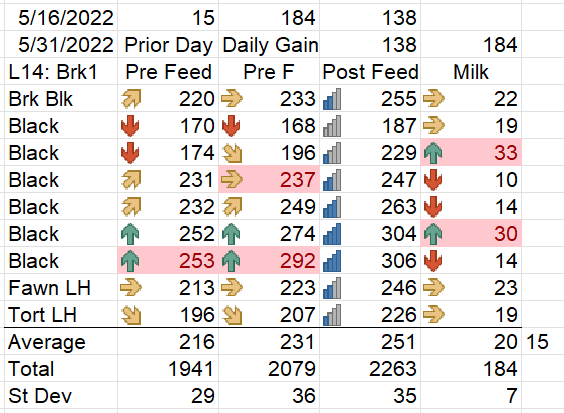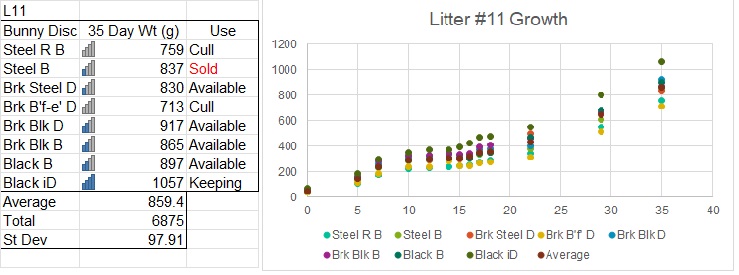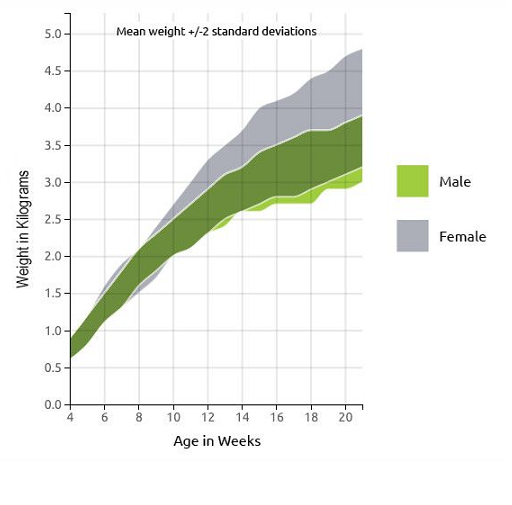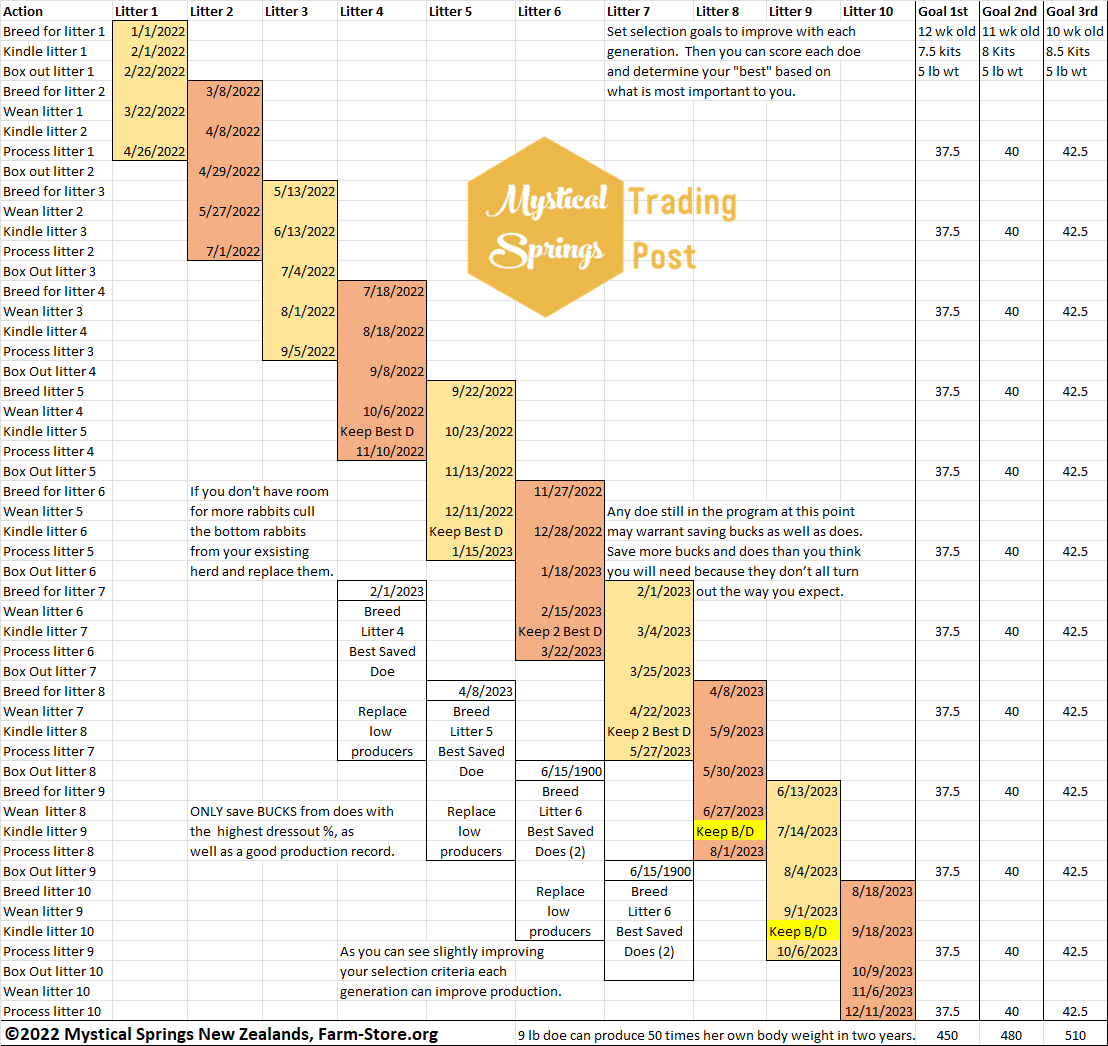Rabbit Math: How much meat can rabbits produce?
Heritability is important in meat rabbit selection, for example, rate of gain is inversely correlated with litter size. This means the the larger the litter size the lower the growth rate. If the breeders select only for weight gain, for example, saving the heaviest bunnies for weight from the entire herd, before long you will have a herd with great weight gain and a litter size of 4. Conversely, selecting only for the largest litters, you will have a herd of rabbits weaning 12 tiny rabbits. Balancing selection is difficult, more of an art than a science.


Selection for high milk production is done by selecting for 21 day litter weight. Generally, a NZ doe will produce between 150-300 grams of milk per day. Some bunnies will get the max, 30 g per day, some bunnies will only get 2-5 grams and barely survive. Selecting for the highest litter weight at 21 days selects for milk production, assuming the litters were balanced up and the doe is nursing an adequate number of bunnies. 4 bunnies are never going to weight as much as 8 no matter how much milk the doe produces. Conversely, a litter of 12 is starting out at a disadvantage in individual weight but maximum litter gains.
Other considerations include environmental expenditures of energy. If the bunnies are cold or wet, they use their energy to survive rather than grow. As young bunnies cannot regulate their body temperature, they must be warm in the nest to be able to digest the food they ingest.
If you would like to purchase some rabbits raised under these selection priorities, visit Farm-Store.org
The weight gain of the litter between 3 and 5 weeks results from the milk produced by the doe + the feed they consume + the adequacy of the intestinal flora obtained from the mother. If your going to introduce green feeds, now is the time, SLOWLY. Anything the mother eats will stimulate her intestinal microorganisms to healthily digest the treat given. The bunnies will actually eat the mothers poop, she intentionally leaves a few droppings in the nest box for the bunnies to eat every day, this builds the proper intestinal community in the bunnies.


Weight after weaning is all related to feed quality and genetic potential of the bunnies. When the litter is full fed after weaning, they grow very rapidly. This is where feeding hay, greens, grains, or feed can affect the weight gain. Producers must balance feeding, like any meat producing animal, to determine what is more valuable-time or money. If your goal is maximizing gains, full feeding high protein, high energy feed may be desirable. If budget is the most important factor, rabbits will happily grow on hay and grass, if you don’t mind holding on to them a few weeks longer. Both extremes have the dangerous potential for digestive upset, which for rabbits can be easily fatal. I balance feeding, giving unlimited hay, limited pellets, and very limited greens and grains.
Optimal diet consists of ~70% high quality hay, 25% high quality pellets, and MAX 5% (Dry weight) greens and treats. Between weaning and processing, expect each rabbit to consume 350 Kcal/day, or at least 150 grams feed. Expect a feed conversion of 1 pound of live weight for every 4 pounds of feed or better. Gain can be faster on higher energy ration, but up to 70% mortality can occur if the diet contains corn. Learn More.
Putting it all together
Minimum standards for meat rabbit does, plan for two cages for each doe. Assumptions include breeding doe starting Jan 1, deliver babies (Kindle) 31 days after breeding, remove nest box when litter is 21 days old, breed doe back when litter is 5 weeks old, wean litter at 7 weeks by removing doe to her other cage. This allows you to leave the litter in their cage until processing, assuming 10 weeks old and 4 lb weight.
Frequently, the doe will loose her first litter, this just happens, breed her back right away if she does. Most common is delivering on the wire, not pulling fur, or eating the litter. Another problem is the doe doesn’t feed her litter, does not produce milk, or produces too much milk. Don’t save replacements from the does first litter! I recommend starting to save replacement does from a does 4th litter and beyond. Any doe living up to expectations after 4 litters and beyond is worthy. Does not producing should be culled, or at the very least, not have replacements saved from her.
Processing weights can be the most significant factor in profitability. If raising rabbits for yourself, you can raise any size, type, or color of rabbit you want to. You can keep them going as long as you want to grow them to whatever size you choose. 3 lb 7 week old’s can be processed right away, or they can be held in grow out pens to 5.5 lbs at 12-14 weeks. If your SELLING live to a processor, you need NZW and/or Californians that make exactly 5 to 5.5 lbs before 12 weeks of age. Also you will get far less money for these animals because the buyer, transporters, processor, marketer, retailer, packagers, inspector and government must all be paid as well.
If you set minimal standards, you will find your saving the right replacements. If you expect 7 weaned from each doe, and she weans 8 or 9, this gives you 1-2 replacements to save. Save the large healthy doelings free of defects. Only save bucklings free from defects, from the top 10% of does for production, the top 10% of the litter for weight, and of only the best type.
Sample breeding schedule for meat rabbit production

The above schedule is an example breeding plan. Set aside two cages for every doe in your program, this allows you to allow your young rabbits to grow to your target weight for processing. Rabbits are capable of producing 50 times their own weight in live offspring in 2 years, and this can be done with the same weight, type, and quality of feed which would allow a beef cow to produce half her weight in weaned calf. Rabbits on a high forage diet have a 4:1 feed:gain ratio while cattle have 10:1, additionally, feeding cost for the maintenance of the doe rabbit consists of only 1/10th of the feed used by the litter, while the maintenance requirements for a beef cow may exceed 200% of the feed required for the calf directly. There is also a difference is time, work, and management. Rabbits MUST have their food brought to them and their waste taken away, but with the way cattle are raised these days it’s only different in the use of heavy equipment. The cow herd can be housed on pasture and pasture bred, this represents a vast reduction in work over rabbit production. The person who successfully designs an automated rabbit production system which includes a waste removal system that can handle manure, urine, and loose hair-while being safe for young rabbits, quiet, and without adding moisture will make rabbit raising the greatest food production system ever!
Begin saving replacement does from the 4th litter of any doe who can stand up to this production strategy. Save the best bucks from each litter of any doe still hanging with the program for 9 and 10 litters. This gives 7-8 does and 2 bucks to save as improved replacements from each doe, and the production potential of these replacements will far exceed any other improvement strategy. 17-20% improvement in production can be made every generation and after 10 litters in two years, the doe herself can be processed to finish her career with producing 50 times her weight in meat.**
Important Information
MOST IMPORTANT!!! Cull any doe that looses more that one litter, produces major faults, small litters, has illness, or will not breed back. Also, cull does that don’t make a good nest. Cull does PRIOR to the point you start selecting replacement stock. Don’t save replacements from a does first three litters. WAIT until you have time to assess the does TRUE qualities! You need at least 30 bunnies from one breeder to gather a statistically significant data set to evaluate.
Breed at least 2 does at the same time, in case you need to foster bunnies and to tell if an environmental factor caused any problem that occurred. You can start selecting for additional production characteristics such as teat number and dress out percentage once you have thirty or more individuals to asses. Even if you sell your fryer rabbits I am quite sure the processor will be willing to let you know how your rabbits “test out.” These are actually some of the most highly inherited characteristics but of course to test dress out you have to process A LOT of rabbits.
Prioritize your selection: I feel litter size is the most important factor because it allows rapid selection for everything else. If your does only raise 2-3 bunnies in every litter your not going to be able to improve anything. Bottom line, they are YOUR rabbits, you put the time, effort, and money into them, you can select for anything you want.
***ALWAYS REMEMBER***
Breeders don’t sell their BEST, don’t expect to be able to buy the “best of the best” stock at any price! Anyone telling you they are selling you their best is a scammer. YOU need to select the best for you, under your conditions! The easiest way to assure someone isn’t going to last in rabbits is for them to go all over and buy rabbits (especially older rabbits) from several different breeders. The litters they will get, if they get any at all, will be a complete mish-mash of genetics and no better than mutts. Even if they do happen to get one or two “nice ones” they will not breed true, and generally the good genetic combinations are scattered to the wind. Line breeding is the only way to be successful in producing quality in any domesticated species consistently.
**Note: I have never been able to do this final step, after having a good girl for two years, I let her retire-literally go out to pasture, in doe wonderland!


